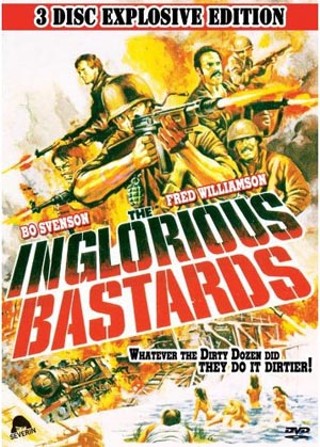Don't Fear the Devil
Some glorious bastards, new to DVD
Fri., Aug. 1, 2008

The Inglorious Bastards: 3 Disc Explosive Edition
Severin Films, $29.95Marry the gut-level contradictions found in Samuel Fuller's movies, the action poetry of Sam Peckinpah's work, and the verve and intensity of the exclusively male combat units seen in the war films of any number of American filmmakers from Robert Aldrich to Darryl Zanuck, and you'll get a sense of what you're in for when you strap on the newly released disc of Italian director Enzo Castellari's The Inglorious Bastards. This English-language war film was made in Italy in 1978 and is set in Nazi-occupied France in 1944. At the outset, a paddy wagon of American soldiers who are being driven to the stockade to await court-martial comes under German attack while en route. Five prisoners survive the assault, and with nothing but certain recapture if they return to the American base, they decide to push on through enemy territory to neutral Switzerland. On the run from the Germans and the Allies, this band of bastards fights its way forward with cunning, daring, instinct, and, ultimately, altruism, once they inadvertently land in the midst of a precarious covert operation.
It's this nugget of a plot setup that is surely what Quentin Tarantino will borrow when he makes his own World War II movie titled Inglorious Bastards. While Castellari's movie, which is receiving its first real U.S. release with this DVD, stands on its own as a terrific war film, it's naturally receiving heightened interest because of Tarantino's interest. Tarantino has never made any secret of his love for "men on a mission" movies, and The Inglorious Bastards is a glorious example of the form.
Severin Films' three-disc package showcases a pristine print. The film's action sequences are truly impressive, even more so when you see stars Bo Svenson, Fred Williamson, and some of the others performing their own stunts. On disc one, extras include Castellari's commentary track and a conversation between Tarantino and Castellari that was recorded just a few weeks ago, as Tarantino was finishing his own script. While natural-seeming (Tarantino's markedly disheveled look almost denies the presence of a camera), the talk ultimately reveals more about Tarantino than Castellari. The documentary on disc two, Train Kept a-Rollin' by Federico Caddeo, features interviews with Castellari, Williamson, Svenson, special-effects artist Gino de Rossi (nicknamed Bombardoni), and others and offers the most significant insights into the film. Another locations featurette contributes little extra value, and, on the whole, the extras become rather repetitive when viewed as a set. The third disc is a soundtrack CD. – Marjorie Baumgarten








